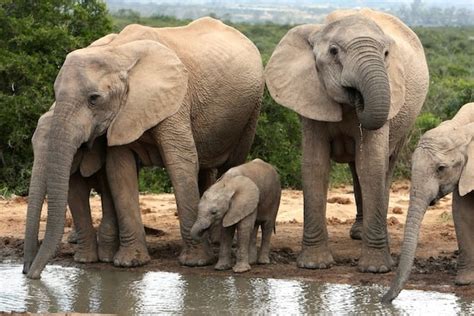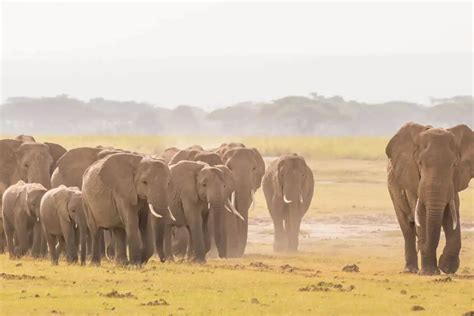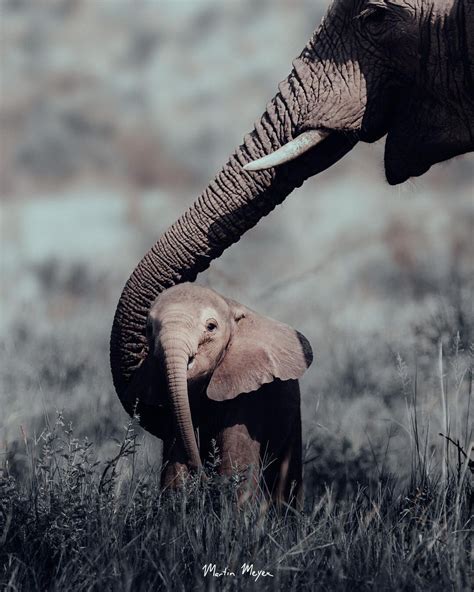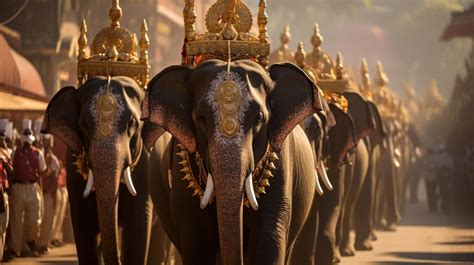In the vast realm of symbolism, there exists a mesmerizing cluster of metaphors that paint a profound picture of unity, power, and wisdom. Let us embark on a captivating journey through the intricate symbolism surrounding a harmonious assemblage of mighty titans, the enchanting elephants.
Within the depths of ancient folklore and mythologies worldwide, one can discern the awe-inspiring presence of these majestic creatures, captivating minds for centuries. Revered for their remarkable intelligence, indomitable strength, and remarkable familial bonds, the elephants have infused themselves into the tapestry of human imagination, ever the muse behind intricate narratives.
Unfolding the layers of this captivating symbolism, we uncover a paramount metaphor for unity and solidarity. Like an intricate puzzle, the elephants, when symbolically linked together, represent the power of a collective. Their unwavering loyalty to their kin and unwavering cooperation in maintaining an interwoven tapestry of social structure illicit admiration among humans, reminding us of the importance of forging strong bonds and interdependence.
The Power of Unity: Significance of Group Behavior among Elephants

In the realm of the majestic creatures known as elephants, the concept of unity holds immense importance and plays a vital role in their social structure. This article aims to delve into the significance of group behavior among these magnificent beings, highlighting their innate ability to communicate, cooperate, and thrive together. With tightly-knit bonds and a strong sense of community, elephants exhibit remarkable teamwork and coordination, paving the way for their survival and success in their natural habitat.
The foundation of elephant society lies in their remarkable aptitude for communication and collaboration. Through a complex system of vocalizations, body language, and tactile interactions, elephants effectively transmit information and convey emotions within their group. Each individual is an integral part of the collective, with various roles and responsibilities as they navigate their environment. This unity not only strengthens their social bonds but also enhances their ability to locate resources, protect each other from threats, and raise their young effectively.
Furthermore, the power of unity among elephants is vividly demonstrated through their synchronized collective behavior. During migrations or when faced with challenges such as predators or environmental obstacles, elephants come together in a synchronized manner, seamlessly orchestrating their movements and actions. Their ability to think and act as one coherent unit not only elevates their chances of survival but also exemplifies the unparalleled synergy that lies within their social structure.
| Key Aspects | Explanation |
|---|---|
| Cooperative Parenting | Elephants exhibit cooperative parenting, with multiple individuals assisting in the care and protection of the young ones. |
| Collective Decision Making | When faced with important decisions such as changes in migration routes or locating water sources, elephants rely on collective decision-making processes. |
| Alertness and Protection | By forming a tight-knit formation known as a "wall of elephants," they shield vulnerable members from potential threats and display a remarkable sense of solidarity. |
| Emotional Support | Elephants display empathy towards one another, providing emotional support during times of distress or mourning. |
It is through their strong unity and group behavior that elephants have not only survived but flourished throughout the ages. Their remarkable ability to work together and support one another is a testament to the power of unity in the natural world. By observing and understanding the significance of their group behavior, we can gain valuable insights into the intricate dynamics of these remarkable creatures and, perhaps, learn valuable lessons about the importance of collaboration and cooperation in our own lives.
Protectors of the Earth: Elephants as a Symbol of Environmental Conservation
In the realm of environmental conservation, elephants hold a significant place as symbols of strength, wisdom, and the immense value of preserving our planet. These magnificent creatures have long been revered for their role as guardians of the natural world, embodying the principles of balance, harmony, and interconnectedness. As they traverse vast landscapes and play a vital role in maintaining ecosystems, elephants serve as powerful ambassadors for the urgent need to protect and sustain our fragile Earth.
Stewards of Balance and Harmony
Elephants, with their majestic presence and gentle demeanor, evoke a sense of awe and respect among cultures around the world. Their ability to shape and transform their environment, while also nurturing and maintaining its delicate equilibrium, offers valuable lessons in sustainability and ecological responsibility. Elephants' role as stewards of balance and harmony serves as a reminder of our duty to coexist harmoniously with nature, ensuring the preservation of ecosystems for generations to come.
Guardians of Biodiversity
Beyond their symbolic significance, elephants play a crucial role in preserving biodiversity. As keystone species, they have a profound impact on their surroundings, creating and maintaining habitats for countless other organisms. By uprooting trees and clearing paths through dense vegetation, elephants shape their environment, allowing sunlight to reach the forest floor and enabling the growth of diverse plant species. In turn, this attracts a wide range of animals and insects, contributing to a thriving ecosystem with balanced populations and healthy biodiversity.
Champions of Conservation
Elephants' vulnerability to habitat loss, poaching, and human-wildlife conflict underscores the need to prioritize environmental conservation efforts. Their plight serves as a rallying cry, mobilizing individuals, governments, and organizations to take action against the destruction of natural habitats and unsustainable practices. By understanding and addressing the complex challenges faced by elephants, we pave the way for broader conservation initiatives that safeguard not only this remarkable species but also the entire web of life dependent upon a healthy and intact environment.
In conclusion, elephants represent far more than gentle giants with immense strength. As symbols of environmental conservation, they highlight the interconnectedness of all living beings and the urgent need to protect our planet. By recognizing and celebrating the significant role elephants play in maintaining ecological balance and biodiversity, we can strive towards a future where humanity lives in harmony with nature, preserving the Earth for future generations.
Wisdom and Knowledge: Unveiling the Intellectual Capacity of Pachyderms

Delving into the cognitive capabilities of elephants sheds light on their unparalleled wisdom and knowledge. Exploring the depths of their intellectual capacity provides insight into the intricate workings of these magnificent creatures.
Unmatched Mental Aptitude: Elephants exhibit an extraordinary level of mental acuity, surpassing that of many other animals. Their ability to exhibit complex social behaviors, problem-solve, and display emotional intelligence highlights their advanced cognitive capabilities.
Memory Mastery: With exceptional memory recall, elephants possess an astounding ability to remember vast amounts of information. From recognizing individual faces and vocalizations to recalling seasonal patterns and migration routes, their remarkable memory contributes to their overall intellectual prowess.
Insightful Learning: The capacity of elephants to acquire knowledge through observation and experience is a testament to their innate intellect. They demonstrate a remarkable ability to learn from their surroundings and adapt their behaviors accordingly, showcasing their aptitude for insightful learning.
As we peel back the layers of their intellectual capacity, fascinating discoveries concerning the wisdom and knowledge of elephants await. By understanding the intricate workings of their minds, we gain a deeper appreciation for these extraordinary beings.
Strength in Numbers: Understanding the Symbolic Power of a Herd
When it comes to the symbolism of a group of elephants, there is an undeniable sense of strength and power that emanates from their unity. In nature, animals often find safety and protection in numbers, and elephants are no exception. The dynamic and coordinated nature of a herd not only allows them to defend against potential threats but also plays a significant role in their social structure and overall survival.
One key aspect of the symbolic power of a herd of elephants lies in their collective strength. Individually, elephants are known for their immense physical power, but when they come together as a group, their combined force becomes even more formidable. The unity and cohesion within a herd enable them to navigate challenging terrains, overcome obstacles, and protect themselves and their young from predators.
- Unity: Within a herd, elephants maintain a strong bond and sense of unity. They rely on each other for support and cooperation, playing a pivotal role in the herd's success and overall well-being.
- Protection: The sheer size and number of elephants within a herd create an imposing presence, deterring potential threats. Additionally, when faced with danger, they work together to defend the group, employing strategies such as forming a defensive circle around their young.
- Wisdom: Another symbolic aspect of a herd is the passing of knowledge and wisdom from older, experienced elephants to the younger generation. The herd acts as a collective teacher, ensuring the survival of their species through shared knowledge and experience.
- Emotional Support: Elephants are known for their strong social connections and the care they show towards one another. In a herd, they offer emotional support, demonstrating compassion and empathy, which further strengthens their bond and contributes to their collective strength.
In conclusion, the symbolism of a herd highlights the strength and power that comes from unity and collaboration. Elephants embody these qualities through their collective strength, protection, wisdom, and emotional support within their herds. By understanding and appreciating the symbolic power of a herd, we can draw inspiration from the elephants' example and recognize the importance of unity and cooperation in our own lives.
Interconnectedness: Exploring the Social Dynamics within Elephant Groups

In this section, we delve into the intricate social dynamics that exist within elephant groups and explore the interconnectedness that binds them together. By examining their complex relationships, communication techniques, and group behavior, we gain a deeper understanding of the intricate society that evolves within these majestic creatures.
1. Communication and Language
- Examining the various methods of communication elephants utilize to convey their intentions and emotions
- Exploring the role of vocalizations, body language, and tactile interactions in social bonding
- Analyzing the importance of infrasound communication in long-range communication and maintaining group cohesion
2. Hierarchy and Leadership
- Investigating the establishment and maintenance of hierarchies within elephant groups
- Exploring the role of matriarchs and the intricate dynamics of female-led societies
- Understanding the influence of age, size, and experience on leadership roles
3. Cooperation and Collaboration
- Examining the ways in which elephants cooperate and collaborate within their groups
- Exploring the collective decision-making processes in relation to movement, foraging, and protecting the herd
- Analyzing the role of teamwork in solving complex problems and ensuring group survival
4. Family Bonds and Social Bonds
- Investigating the formation and significance of family units within elephant groups
- Exploring the strength of social bonds between family members and non-related individuals
- Understanding the implications of social ties in terms of protection, reproduction, and emotional support
Through a holistic examination of interconnectedness within elephant groups, we gain insights into the fascinating social dynamics that shape their lives. By understanding their complex relationships, we can better appreciate and conserve these extraordinary creatures and the importance of maintaining their interconnected communities.
Spiritual Beliefs: Elephants as Sacred Beings in Various Cultures
Throughout the annals of history, elephants have held a special place in the spiritual beliefs of numerous cultures. Revered for their majestic presence and awe-inspiring qualities, these magnificent creatures have been recognized as sacred beings, embodying divine attributes and representing profound symbolism in diverse traditions.
Guardians of Wisdom and Prudence:
In many Eastern cultures, elephants are seen as guardians of wisdom and prudence. The strength and intelligence exhibited by these gentle giants are believed to embody qualities that are highly regarded in spiritual teachings. Their sagacious nature symbolizes knowledge, foresight, and a deep understanding of the intricacies of life, making them revered messengers of wisdom in various religious and philosophical systems.
For example, in Hinduism, the deity Ganesh, often depicted with the head of an elephant, is worshipped as the remover of obstacles and the bestower of prosperity. The association of Ganesh with elephants reflects the belief in their spiritual powers to guide and protect individuals in their earthly journeys.
Embodiments of Sacred Connections:
Elephants also play a significant role in symbolizing sacred connections in different cultures. With their strong family bonds and nurturing behavior towards their young, elephants represent the importance of harmony, unity, and the interconnectedness of all living beings.
In certain African tribes, elephants are revered as spiritual beings that possess ancient wisdom and serve as ancestral spirits. They are believed to be intermediaries between the physical and spiritual realms, capable of establishing a profound connection between humans and their departed ancestors.
Manifestations of Power and Royalty:
The grandeur and magnificence of elephants have often associated them with power, authority, and royal prowess. Their immense size and commanding presence make them a symbol of strength, leadership, and nobility in numerous cultural contexts.
For instance, in Thai culture, the white elephant is considered a sacred animal and a symbol of royalty. It is believed that the Thai king's possession of white elephants represents his divine right to rule and his close connection with the spiritual realm.
From ancient civilizations to modern societies, elephants have captivated the imagination and held a significant place in the spiritual beliefs of many cultures. Whether revered for their wisdom, seen as intermediaries between realms, or symbolic of power and royalty, these sacred beings continue to inspire awe and reverence, reminding humanity of the profound connections between the physical and spiritual realms.
Maternal Bonds: The Symbolism of Family and Motherhood in Elephant Herds

Within the realm of elephant herds, there lies a profound symbolic significance in the existence of familial and maternal bonds. These bonds form the foundation of the elephants' social structure, emphasizing the importance of family and motherhood in the intricate tapestry of their lives.
In the world of elephants, family is not merely a grouping of individuals, but a network of intricate relationships that play a pivotal role in the social dynamics. Mothers, in particular, hold a special place within the herd, as they take on the responsibility of nurturing and protecting their offspring. They embody the essence of unconditional love, providing guidance, support, and a sense of belonging.
- The bonds between mother and child are forged from the moment of birth, where tender moments of nursing and physical contact solidify the deep connection between them.
- Mothers serve as pillars of strength and wisdom, imparting valuable life lessons and social skills to their young ones.
- These maternal bonds extend beyond individual families, as elephants also uphold a communal approach to motherhood. Older females, known as "aunties," often assist in raising and caring for the calves, reinforcing the collective responsibility towards the well-being of the next generation.
- The importance of these maternal bonds becomes evident during times of danger or distress. In the face of threats, elephants band together, led by the matriarch and supported by the unified strength of the herd, ensuring the safety and protection of their young ones.
- The symbolism of family and motherhood in elephant herds resonates beyond the animal kingdom. It serves as a powerful reminder of the significance of nurturing relationships, the strength in unity, and the transformative power of love and care.
Ultimately, within the vast expanse of an elephant herd, the symbolism of family and motherhood emerges as a guiding force–a testament to the unbreakable bonds formed between generations, emphasizing the profound influence and enduring nature of maternal love.
Endangered Majesty: Utilizing Elephant Symbolism to Advocate for Conservation
In this section, we will delve into the powerful symbolism of elephants and explore how it can be effectively used to raise awareness and advocate for the conservation of these magnificent creatures. By harnessing the profound significance attached to elephants in various cultural and religious contexts, we can create a compelling narrative that highlights the urgent need for active conservation efforts.
- Sacred Guardians: Throughout history, elephants have been revered as sacred beings in many cultures. Their majestic presence and the wisdom they are believed to possess make them an ideal symbol for conservation. By portraying elephants as guardians of the earth and stewards of the natural world, we can emphasize the importance of protecting their habitats and preserving biodiversity.
- Icons of Strength: Elephants are renowned for their immense physical strength and resilience. By depicting them as symbols of power and endurance, we can inspire individuals to recognize the critical role these animals play in maintaining the ecological balance of their habitats. Their conservation becomes an essential aspect of preserving the delicate equilibrium of our planet.
- Harbingers of Prosperity: In many cultures, elephants symbolize prosperity, abundance, and good fortune. By associating conservation efforts with the idea of preserving the natural resources essential for prosperity, we can foster a sense of collective responsibility towards safeguarding elephant populations and their habitats.
- Interconnections in Ecosystems: Elephants occupy a unique ecological niche, shaping their habitats through their feeding and movement patterns. By highlighting the interconnectedness of ecosystems and the cascading effects of elephant conservation, we can illustrate how protecting these magnificent creatures also safeguards the well-being of countless other species.
- Cultural Heritage: Elephants hold deep cultural significance in various communities worldwide. By emphasizing the endangered status of these majestic animals, we can call upon the shared cultural heritage associated with elephants to stimulate action and mobilize communities towards conservation efforts.
Through the strategic use of elephant symbolism, we can not only captivate audiences but also inspire them to take concrete steps towards the conservation of these endangered creatures. By recognizing and protecting the majesty of elephants, we contribute to the preservation of biodiversity and the sustainability of our planet's ecosystems.
From Myth to Reality: Tracing the Historical Significance of Elephants in Human Culture

The evolution of human civilization has been intricately woven with the presence of elephants, creating a rich tapestry of myth and reality throughout history. These majestic creatures have served as revered symbols and sources of inspiration in various cultures worldwide, leaving an indelible mark on human culture.
Throughout the annals of time, elephants have symbolized power, wisdom, and strength, embodying both the human desire for dominance and reverence for the natural world. The historical significance of elephants can be traced back to ancient civilizations such as Egypt, where they were associated with divinity and held a central role in religious rituals and ceremonies.
In other cultures, elephants have been revered as symbols of wisdom and sagacity, their sheer presence captivating the human imagination. From the fables of Aesop to the ancient Indian scriptures, elephants have been depicted as noble beings that possess a deep understanding of the world. Their extraordinary memory and intricate social structures inspire awe and admiration, reflecting the human longing for knowledge and harmony.
Furthermore, elephants have played a pivotal role in human warfare and transportation throughout history. These colossal creatures have been harnessed and trained for military purposes, capable of instilling fear and exerting dominance on the battlefield. Their strength and loyalty have made them crucial allies, carrying armies across vast distances and shaping the outcome of conflicts.
As human civilization has progressed, the historical significance of elephants has evolved. Today, these magnificent beasts are not only revered but also face numerous threats due to human activities. The preservation of their habitat and protection from illegal practices has become a pressing concern, as we strive to ensure the survival of a species deeply woven into the fabric of our cultural conscience.
In conclusion, the historical significance of elephants in human culture is a testament to their profound impact on our collective imagination. From ancient myths and legends to their role in warfare and transportation, these gentle giants have left an indelible mark on our history. Recognizing the importance of elephants and taking active measures for their conservation is not only a responsibility but also a tribute to their enduring legacy.
FAQ
What does the symbolism of multiple elephants represent in different cultures?
In various cultures, multiple elephants symbolize strength, power, wisdom, and protection. They are often associated with good luck and prosperity. In Hinduism, for example, Lord Ganesha, the elephant-headed deity, is revered as the remover of obstacles and the god of wisdom and success.
Are there any specific meanings attached to the color of the elephants?
While multiple elephants generally carry positive symbolic meanings, the color of the elephants can also add depth to their symbolism. White elephants, for instance, represent purity and spiritual enlightenment. Black elephants, on the other hand, are often associated with mystery, transformation, and the divine feminine energy.
Do multiple elephants in dreams have any personal meanings?
Yes, the presence of multiple elephants in dreams can have personal significance. It may indicate the need for strength, unity, and loyalty in your relationships or social circles. It could also represent a desire for success, stability, and protection in your personal or professional life. Analyzing the specific context and emotions within the dream can help uncover its personal meaning.
What is the significance of multiple elephants appearing in artworks?
In artworks, multiple elephants often symbolize harmony, teamwork, and a sense of community. They represent the idea of working together for a common goal and establishing strong foundations. Furthermore, the presence of multiple elephants in artwork can evoke a sense of awe and majesty, reminding us of the magnificence and grandeur of nature.
Are there any negative interpretations associated with multiple elephants?
While multiple elephants are generally seen as positive symbols, some interpretations suggest that an overwhelming number of elephants in dreams or artworks may represent feelings of being burdened or overwhelmed by responsibilities. Additionally, in certain cultures and mythologies, large herds of elephants have been associated with destructive forces and chaos.
What is the symbolism behind multiple elephants in dreams?
In dreams, multiple elephants symbolize strength, power, and unity. The presence of a herd of elephants may represent a strong support system or a close-knit community in one's life. It can also signify a need for solidarity and cooperation to overcome challenges.



